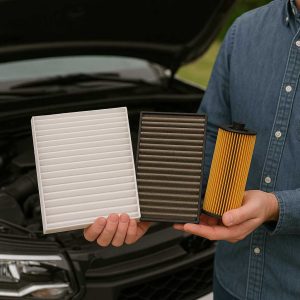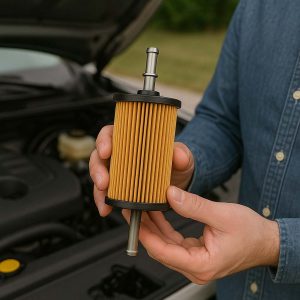Car filters are small, affordable components that play a huge role in maintaining the performance, efficiency, and longevity of your vehicle. Whether it’s the engine air filter, oil filter, fuel filter, or cabin air filter, each one ensures that the systems they serve are free of contaminants and working at their best.
But how often should you replace each type of car filter? The answer depends on the filter type, your driving habits, and the conditions you typically drive in. In this article, we’ll explore ideal replacement intervals for each car filter and provide maintenance tips to keep your vehicle running smoothly.
Why Car Filters Matter

Filters prevent debris, dust, contaminants, and particles from entering critical areas of your car, such as the engine, fuel system, and the air you breathe in the cabin. Worn or clogged filters can cause:
-
Engine performance loss
-
Increased fuel consumption
-
Cabin air quality issues
-
Long-term mechanical damage
Overview of Car Filter Replacement Intervals
Here’s a quick look at average replacement intervals for key car filters:
| Filter Type | Recommended Interval | Notes |
|---|---|---|
| Engine Air Filter | Every 15,000–30,000 km | Replace sooner in dusty/off-road conditions |
| Cabin Air Filter | Every 12,000–20,000 km | More frequent in urban or high-pollen areas |
| Oil Filter | Every 5,000–10,000 km (with oil) | Replace with every oil change |
| Fuel Filter | Every 30,000–60,000 km | Depends on fuel quality and driving environment |
| Transmission Filter* | Every 50,000–100,000 km | *Applies to automatic transmissions only |
Engine Air Filter: Keeping Combustion Clean
The engine air filter prevents dirt, debris, and dust from entering the engine’s combustion chamber. A clean filter ensures optimal air-fuel mix and smooth acceleration.
When to Replace:
-
Every 15,000–30,000 km
-
Every 12 months, or sooner in dusty/off-road environments
Symptoms of a Dirty Air Filter:
-
Reduced fuel efficiency
-
Engine misfires or rough idling
-
Decreased acceleration
Tip:
Inspect your air filter every 10,000 km, especially if you drive in polluted or dusty areas.
Cabin Air Filter: Breathing Clean Inside
This filter traps pollen, dust, and contaminants from entering the interior HVAC system. It’s vital for cabin air quality, especially for allergy sufferers.
When to Replace:
-
Every 12,000–20,000 km
-
At least once a year, or twice if you live in a city or drive in high-pollen areas
Signs It Needs Replacing:
-
Musty smell inside the car
-
Weak airflow from vents
-
Foggy windows that don’t clear easily
Oil Filter: Protecting Your Engine’s Lifeblood
The oil filter captures contaminants in engine oil that can wear down components. Replacing the oil filter ensures the oil remains clean and efficient.
When to Replace:
-
With every oil change (typically every 5,000–10,000 km)
What Happens If You Delay?
-
Dirty oil recirculates in the engine
-
Accelerated wear on internal parts
-
Reduced engine efficiency
Tip:
Always use a high-quality oil filter that meets your engine’s specifications.
Fuel Filter: Clean Fuel, Strong Performance
The fuel filter screens out dirt, rust, and particles from fuel before it reaches the engine. A clogged fuel filter restricts fuel flow and affects performance.
When to Replace:
-
Every 30,000–60,000 km, depending on the make/model
-
More often in regions with poor fuel quality
Symptoms of a Clogged Fuel Filter:
-
Engine hesitation or misfires
-
Hard starts or stalling
-
Poor fuel economy
| Driving Condition | Fuel Filter Service Recommendation |
|---|---|
| Regular highway driving | Every 50,000–60,000 km |
| Urban stop-and-go | Every 40,000 km |
| Off-road/low-quality fuel | Every 30,000 km or sooner |
Transmission Filter (If Applicable)
Automatic transmissions often have their own filters that keep transmission fluid clean.
When to Replace:
-
Typically every 50,000–100,000 km
-
Alongside transmission fluid flush
Signs of a Dirty Transmission Filter:
-
Gear slippage
-
Delayed or hard shifting
-
Transmission overheating
Filter Maintenance Tips

Keep your vehicle in top shape with these simple maintenance practices:
-
Check filters during routine servicing – Most mechanics will inspect them during oil changes.
-
Follow your owner’s manual – Each vehicle has specific recommendations.
-
Adjust based on conditions – Harsh environments shorten filter lifespan.
-
Use quality replacements – Low-grade filters may fit poorly and filter less effectively.
-
Don’t ignore symptoms – Engine hesitation, poor airflow, or strange odors may indicate a filter issue.
How Driving Conditions Affect Filter Life
| Driving Environment | Effect on Filters | Action |
|---|---|---|
| Dusty or off-road roads | Faster clogging | Replace air/cabin filters more often |
| Urban traffic | More airborne pollutants | Monitor cabin filter and engine performance |
| Cold or humid climates | Risk of moisture or salt buildup | Check for rust/corrosion on filter housings |
| High-speed driving | Increases oil/fuel demand | Maintain oil and fuel filter replacement |
Final Thoughts
Replacing your car’s filters on schedule is one of the easiest and most cost-effective ways to protect your engine, improve performance, and enhance driving comfort. While you don’t need to replace them all at once, keeping a regular maintenance log helps ensure nothing is overlooked.
Want quality filters for your vehicle?
Buy Car Filters online — Explore a wide range of OEM-quality air, oil, fuel, and cabin filters that fit your make and model perfectly.
Summary Table: Filter Replacement Intervals
| Filter | Replace Every (km) | Replace Every (Time) |
|---|---|---|
| Engine Air Filter | 15,000–30,000 | 12 months |
| Cabin Air Filter | 12,000–20,000 | 6–12 months |
| Oil Filter | 5,000–10,000 | With every oil change |
| Fuel Filter | 30,000–60,000 | Every 2–3 years |
| Transmission Filter | 50,000–100,000 | With fluid service |